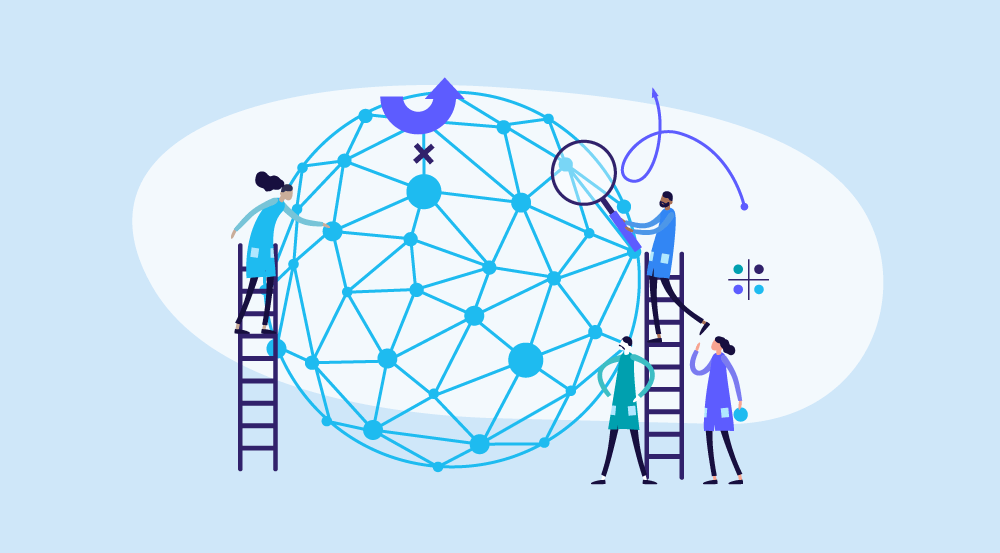Closing skills gaps is crucial for talent management.
However, these gaps have increased due to technological advancements, labor expectations, and environmental awareness.
The good news is that once you understand the reasons behind the skills gaps in your industry, you can start addressing them within your organization.
By analyzing your employees' abilities and talents, you can find ways to close these gaps.
This can be done by either upskilling and reskilling talented individuals or by bringing in new workers with the needed skills.
Before you can address the lack of abilities within your talent pool, you need to identify which gaps exist in your organization.
These gaps can be related to skills, knowledge, or both.
Having said that, there’s a lot more to closing skill gaps in the workplace and at an individual level, than what meets the eye.
This post serves that purpose i.e. talk about how to identify skill gaps in the workplace, essential aspects of skills gaps, and the role of an organization in that sense.
Let’s get started.
What Is a Skill Gap From an Organizational Point of View?
A skills gap occurs when employers need certain skills that their current workforce does not possess.
To address this, a skills gap analysis can be performed. This analysis helps identify the specific skills that are necessary to meet business objectives.
By understanding these skills, businesses can then create employee development initiatives and tailor their hiring programs to attract candidates with the needed skills.
Examples of Skill Gaps In The Workplace
Of course, without talking about skill gaps from an exemplary point of view, it’d be hard to grasp the entire concept.
Here are some of the examples of skill gaps in the workplace.
Depending on your organization, the following skill gaps may or may not be there.
Therefore, take it in a general sense.
If you are a manager or someone in charge of identifying skill gaps, these examples can help you with a sense of direction to go with:
Digital Literacy
One example of skill gaps in the workplace is digital literacy.
As technology continues to advance, employees may lack proficiency in using digital tools, software, and online platforms relevant to their job roles.
This includes skills such as using productivity software, navigating databases and utilizing collaboration tools.
The presence of a disparity in digital skills carries consequences.
Collectively, 14 G20 nations face the potential of forfeiting a cumulative GDP growth of $11.5 trillion.
Data Analysis
With the increasing importance of data-driven decision-making, employees might lack the ability to analyze and interpret data effectively.
This includes skills related to data manipulation, statistical analysis, and drawing insights from data.
Critical Thinking
When it comes to skill gaps in the workplace, critical thinking is a huge challenge.
Many job roles require employees to analyze complex situations, make informed decisions, and solve problems creatively.
A lack of critical thinking skills can hinder employees from addressing challenges in innovative ways.
Communication Skills
Effective communication, both written and verbal, is crucial in most workplaces.
Skill gaps in communication can lead to misunderstandings, misinterpretations, and inefficiencies in collaboration.
Adaptability and Flexibility
Industries are evolving rapidly, and employees must adapt to new technologies, processes, and market trends.
A lack of adaptability can result in resistance to change and difficulties in learning new skills.
Employees express apprehension regarding the expanding skills disparity.
According to a survey, 46 percent of respondents hold the belief that their present skillset will lose relevance by the year 2024.
Leadership and Management
In managerial roles, employees may lack leadership skills, such as conflict resolution, team motivation, and effective delegation.
These gaps can hinder team dynamics and overall performance.
Customer Service
Employees interacting with customers might lack the necessary skills to provide exceptional customer service.
This includes skills like empathy, active listening, and problem-solving to address customer concerns.
Creativity and Innovation
In creative or innovative industries, employees might struggle with generating fresh ideas, thinking outside the box, and implementing new concepts.
Cultural Competency
In diverse workplaces, employees might lack the skills to understand and respect different cultural norms, leading to misunderstandings and potential conflicts.
Soft Skills
Soft skills like teamwork, time management, conflict resolution, and emotional intelligence are essential for effective collaboration and maintaining a positive work environment.
Language Proficiency
In multilingual workplaces, language barriers might impede effective communication and collaboration among employees.
Technical Skills
Technical roles often require specific technical skills related to coding, software development, engineering, or other specialized fields.
Sales and Marketing Skills
Employees responsible for sales and marketing might lack skills related to lead generation, negotiation, persuasive communication, and understanding customer needs.
Project Management
Project management skills are essential for coordinating tasks, managing resources, and meeting deadlines.
Skill gaps in this area can lead to project delays and inefficiencies.
Problem-Solving
Employees may lack the ability to identify problems, analyze root causes, and develop effective solutions, which can impact overall efficiency and innovation.
Identifying and addressing skill gaps is crucial for organizations to remain competitive and adapt to changing industry landscapes.
4 Ways How Organizations Can Fill Up Employees’ Skill Gap
Did you know that merely 34 percent of the surveyed employees perceive a sense of backing from their organization's skill enhancement prospects?
Addressing the skills deficit stands as a primary objective.
A significant majority of 64% of Learning and Development (L&D) experts indicated that the immediate emphasis lies in upskilling the existing workforce to bridge skill gaps.
The skills gap analysis serves as a guide, highlighting areas where training is required and providing insights into the types of skills that should be prioritized.
This analysis is not only beneficial for companies but also for individuals looking to enhance their employability.
Step 1: The Planning Part
You can do a skills gap analysis on two levels.
- Skill Comparison
First, you can look at an individual employee and compare their actual skill level to the skills that their job requires.
This will help you identify any gaps that need to be addressed.
- Look at Your Team as a Whole
Second, you can look at your team or company as a whole.
This means determining if your employees have the skills necessary to work on upcoming projects, or if you need to hire new people with the right skills.
Analyzing the skills gap in your team or company can help you focus your employee training programs on the areas that need improvement.
- Initiating the Skills gap Analysis
To initiate a skills gap analysis, your HR department can hold a meeting with managers to explain the process.
It can also be beneficial to hire an external consultant to conduct the analysis.
Bringing in someone from outside the company can provide a fresh perspective and ensure objectivity in the process.
This will also free up your staff to focus on other important work.
Step 2: Identification of Core Skills Needed By an Organization
Sometimes employers struggle to fill job openings because there is a gap in the skills of the available candidates.
However, there are others who argue that skill gaps exist because employers have unrealistic expectations.
- Important Questions to Identify the Required Skills
To identify the skills that are needed, there are two important questions that need to be answered:
What skills does the company value? and What skills are necessary for employees to perform their jobs well both now and in the future?
To determine the skills that the company values, it is important to consider the job descriptions, business objectives, and company values.
By doing this, it becomes possible to understand the new skills that may be required in the coming years.
It can also be helpful to involve the team members in this process by surveying them to gather their insights on the skills that they believe are lacking.
This involvement not only provides valuable input but also helps the employees feel that they are contributing to the growth of the company.
- Go for Numerical Rating Scales
When assessing skill gaps, numerical rating scales can be a practical tool.
These scales can be based on a five-point or three-point system, depending on what is most appropriate for the situation.
It is important to define the scales explicitly, for example, a scale of 1 to 5 could be used to denote a range from poor to excellent or from inexperienced to expert.
Step 3: Measuring Skills
There are multiple ways to measure skill levels, such as surveys, assessments, interviews, and feedback from performance reviews.
- Skill Management Software
Using skills management software like Skills DB Pro or TrackStar can also streamline the process.
- Create a Skills Spreadsheet
Another option is to create a skills spreadsheet for each individual position. A skills gap can sometimes stem from limited experience, particularly in the case of new hires.
In these situations, on-the-job coaching can be a more effective way to address the skills gap instead of formal training.
Let's take an example.
Based on the scores above, an employee may not need training in Customer Relationship Management (CRM) software, but they do have gaps in negotiation and Excel skills.
Since negotiation skills are deemed more important, it would be best to prioritize employee training and development in that area.
By using this approach, companies can effectively address skills gaps and provide targeted training to enhance employee capabilities.
Step 4: Taking Accumulated Data Into Account For Further Action
To fill skills gaps, you have two options: training and hiring.
You need to decide which approach works best for each specific skill gap.
- Train Existing Employees
Some companies choose to train and develop their existing staff to fill open positions.
This is a good option if you have more than half of your staff who are willing to learn new skills.
- You can offer training in specific areas that you want to strengthen, such as using SAP or Excel.
- This kind of training can help bridge the gap between the skills your employees currently have and the skills you desire.
- You can hire professional training firms to arrange workshops, training sessions, and seminars for your staff.
- Along with formal training, you can also provide subscriptions to online courses and educational materials.
- Another option is to offer voluntary employee mentorship programs, as well as opportunities for them to attend events and conferences.
- Additionally, you can encourage your employees to obtain certifications in relevant fields, such as Project Management Professionals (PMP) or Professional Certified Marketers (PCM).
- Hire New Employees
If training alone cannot bridge the skills gaps, then hiring new employees might be necessary.
- In this case, you should modify your hiring process to screen for the specific skills your company needs.
- This can include skills assessments, like writing samples, and numerical reasoning tests.
- Using structured interviews can also help reduce biases and ensure that you are hiring based on job-related criteria.
- To find candidates with the necessary skills, you may need to source passive candidates.
- These are individuals who are not actively looking for a job but have the skills you need.
- Utilize effective sourcing techniques, such as recruiting on social media platforms like Twitter and using advanced search techniques like Boolean logic.
Overall, conducting a skills gap analysis may require some time and effort, but it is worth it.
Knowing which skills your business needs to grow will help you make informed decisions about training and hiring, leading to a stronger and more successful team.
Leveraging Oreed's Innovative Capabilities
Personalized Training Approach
Oreed introduces a pioneering methodology that taps into its innovative capabilities to craft bespoke training and course modules.
These modules are meticulously designed to cater to the distinct strengths and areas of improvement within your team, ensuring a precise alignment of learning objectives with individual needs.
The Path to Outstanding Achievements through Customized Training
By harnessing the potential of Oreed's tailored training approach, organizations unlock the latent capabilities of their workforce.
This strategic method capitalizes on individual strengths, resulting in exceptional accomplishments that drive both personal and organizational growth.
Evaluating Training Effectiveness
Oreed offers robust analytics and reporting features that empower organizations to gauge the impact of their training initiatives.
These insights provide invaluable clarity on the correlation between training strategies and employee performance, enabling informed decision-making and optimizing training investments.
Ensuring Optimal ROI with Oreed's Analytical Edge
With Oreed's analytical prowess, organizations can strategically fine-tune their training efforts for maximum returns.
The data-driven approach ensures that each investment in training translates into enhanced employee performance and overall organizational success.
Fostering Excellence through the Learning Ecosystem
Oreed's comprehensive learning ecosystem instills the values of mastery and discipline within your workforce.
This approach empowers individuals to refine their expertise, polish skills, and embark on personalized learning journeys tailored to their unique requirements.
Our Advocacy for Structured Learning
Structured learning is at the core of Oreed's approach, promoting consistency and continuous progress.
By championing a methodical learning process, the platform ensures enduring growth for individuals and the organization as a whole.
Foster a Culture of Continuous Development
In alignment with the forward-thinking 2030 vision, organizations can cultivate an environment of lifelong learning through Oreed.
Personalized training and data-backed insights empower employees to embrace continuous development, adapt to evolving landscapes, and drive innovation.
So what are you waiting for? Book a demo with Oreed today and find out more about our features.
Promote lifelong learning through Oreed by experiencing the most powerful all-in-one training and development intelligent platform that streamlines all your organization's learning, training, and development activities in one place.
FAQs
How to identify skill gaps in the workplace?
Here’s how to identify skill gaps in the workplace.
Identifying skill gaps in the workplace is essential for effective talent management, employee development, and maintaining a competitive edge.
Here's a step-by-step guide on how to identify skill gaps in your organization:
Define Roles and Competencies
Clearly outline the roles within your organization and the competencies (skills, knowledge, behaviors) required for each role.
This provides a baseline for assessing skill requirements.
Conduct Job Analysis
Analyze each job role to understand its specific requirements. This involves breaking down tasks, responsibilities, and the skills needed to perform them effectively.
Compare Skills
Compare the competencies required for each role with the skills possessed by employees.
This can be done through self-assessment, manager assessment, or performance reviews.
Use Skills Matrices
Create skills matrices that map the required competencies against the current skills of employees. This visual tool helps identify gaps at a glance.
Analyze Performance Data
Review performance data, such as employee performance appraisals, project outcomes, and customer feedback.
Identify trends that might indicate skill gaps affecting performance.
Seek Employee Input
Conduct surveys or informal discussions with employees to gather their perspectives on the skills they believe are lacking for their roles or for career growth.
Observe Workplace Challenges
Pay attention to recurring challenges, bottlenecks, or inefficiencies in processes. These could be indicators of skill gaps affecting workflow.
Compare Industry Trends
Benchmark your organization's skills against industry trends and best practices.
Identify skills that are becoming more critical due to technological advancements or changing market dynamics.
Analyze Training Requests
Review training and development requests from employees or departments. Frequent requests for specific training might indicate skill gaps in those areas.
Monitor Employee Engagement
Low employee engagement or morale might stem from perceived skill gaps hindering their ability to perform effectively.
Examine Succession Planning
Evaluate whether your organization has potential successors for key positions.
If not, it might indicate skill gaps in the talent pipeline.
Utilize Skills Assessments
Administer skills assessments or tests to employees to gauge their proficiency in specific areas. These assessments can provide objective data on skill levels.
Conduct Competency Interviews
In one-on-one conversations, managers can assess employees' competencies and identify areas where they might need further development.
Leverage AI and Analytics
Use AI-driven analytics tools to analyze workforce data, performance metrics, and learning patterns to identify trends and potential skill gaps.
Review Business Goals
Align skill gap analysis with your organization's strategic goals.
Identify skills needed to achieve those goals and assess whether your workforce possesses them.
Regularly Update Analysis
Skill requirements and industry trends change over time.
Regularly revisit your skill gap analysis to ensure it remains up to date.
Once you've identified skill gaps, it's important to create a plan to address them.
This might involve offering training, providing mentorship, encouraging self-directed learning, or considering external hiring.
By consistently addressing skill gaps, you can foster a skilled and competitive workforce that drives organizational success.
Is it absolutely necessary for thriving organizations to do a skill gap analysis in the first place?
While a skill gap analysis is not absolutely mandatory for all organizations, it is highly beneficial and often considered a best practice, especially for organizations that aim to thrive in today's rapidly evolving business landscape.
Here are several reasons why conducting a skill gap analysis is essential for thriving organizations:
Strategic Alignment
Skill gap analysis helps align the skills of the workforce with the strategic goals of the organization.
It ensures that the skills employees possess are in line with the skills needed to drive business growth and innovation.
Competitive Advantage
Thriving organizations are often those that adapt to change quickly and outperform their competitors.
Identifying skill gaps allows organizations to proactively address areas that might hinder their ability to stay competitive.
Innovation and Growth
Skill gap analysis reveals areas where employees lack the skills required for innovation and growth.
Closing these gaps enables employees to contribute more effectively to new initiatives and advancements.
Efficient Workforce Planning
A clear understanding of skill gaps enables organizations to plan for future workforce needs, ensuring that they have the right talent in the right roles to meet business demands.
Talent Development and Retention
Employees value opportunities for growth and development.
Addressing skill gaps through training and development programs can boost employee engagement and retention.
Succession Planning
Thriving organizations plan for the future.
Skill gap analysis helps identify potential successors for key roles, ensuring a strong talent pipeline for leadership positions.
Adapting to Technological Changes
In a rapidly evolving technological landscape, skill gaps related to emerging technologies can hinder an organization's ability to adopt new tools and systems.
Employee Performance and Productivity
Skill gaps can lead to inefficiencies, errors, and lower productivity.
Addressing these gaps improves overall employee performance and effectiveness.
Effective Resource Allocation
Skill gap analysis guides resource allocation for training and development initiatives. It ensures that investments in employee development yield maximum benefits.
Employee Satisfaction and Engagement
Addressing skill gaps demonstrates an organization's commitment to employee growth. This enhances job satisfaction and fosters a culture of continuous learning.
Avoiding Hiring Mistakes
Skill gap analysis helps organizations identify if specific roles require external hiring due to unbridgeable gaps.
This prevents making hasty hiring decisions that may not align with long-term strategies.
Risk Mitigation
Addressing skill gaps reduces the risk of key employees leaving due to dissatisfaction with their growth opportunities or inability to perform effectively.
Organizational Agility
Thriving organizations must be agile in responding to market shifts and customer demands. A workforce with adaptable and up-to-date skills is better positioned to support this agility.
Enhanced Decision-Making
Data-driven decisions are a hallmark of successful organizations.
Skill gap analysis provides insights that inform strategic decisions related to workforce planning and development.





